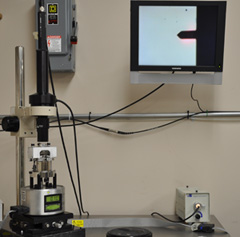Atomic Force Microscope
VEECO MultiMode V and Dimension 3100

Atomic force microscopy is a powerful new technique for to allow imaging of non-conducting surfaces down to the sub-nanometer level without the need for any additional sample preparation. The AFM consists of a sharp tip (10-20 nm diameter) attached to a stiff cantilever. The tip is brought close to the surface and the sample is scanned beneath the tip. The tip moves in response to tip-surface interactions, and this movement is measured by focusing a laser beam onto the back of the cantilever and detecting the position of the reflected beam with a photodiode.
The atomic force microscope is run in two basic modes; contact and tapping. In contact mode the AFM tip is in contact with the surface continuously. Whereas in tapping mode (also called intermittent contact mode) the AFM cantilever is vibrated above the sample surface, so the tip is only in contact with the surface intermittently. This helps reduce shear forces associated with the tip movement. For most imaging in AFM tapping mode is the recommended mode. Contact mode AFM is only used for specific applications, such as force curve measurements.
In summary, the major advantages of AFM are:
- Imaging of conducting and non-conducting surfaces
- Sub-nanometer resolution
- Imaging in air and liquid, allowing in-situ measurements and real time imaging of biological and chemical processes
- AFM can be used to measure and localize many different forces including: adhesion strength, magnetic forces and mechanical properties
- True 3D imaging and measurements
- Magnetic, friction, chemical, and phase imaging

